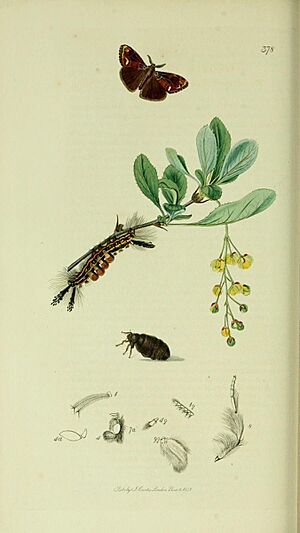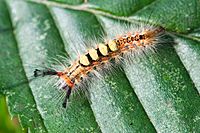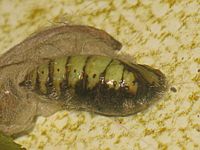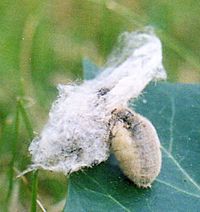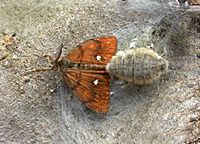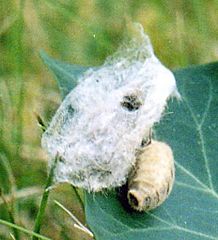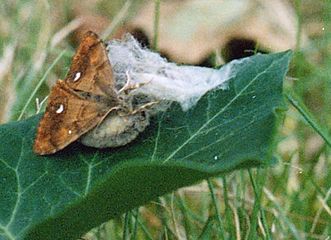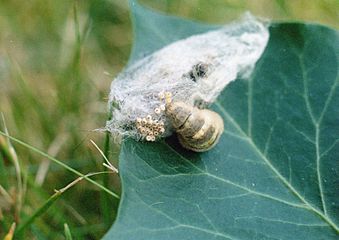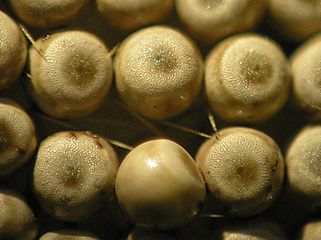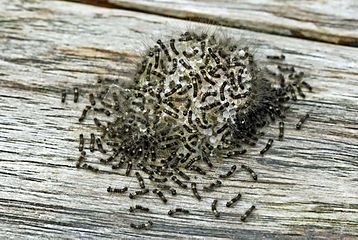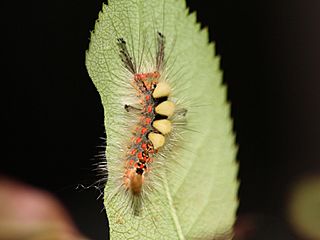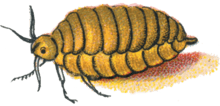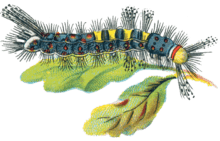Rusty tussock moth facts for kids
Quick facts for kids Rusty tussock moth |
|
|---|---|
 |
|
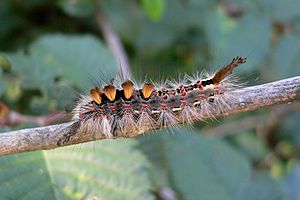 |
|
| male imago and caterpillar | |
| Scientific classification | |
| Synonyms | |
|
The Rusty Tussock Moth, also known as the Vapourer, is a type of moth. It belongs to a group of moths called the Erebidae family.
Contents
Where Rusty Tussock Moths Live
This moth first came from Europe. Now, you can find it across many continents. These areas include parts of Asia, Europe, and North America. The Rusty Tussock Moth is not considered an endangered species. In the UK, it is a very common moth.
Rusty Tussock Moth Habitats
In the UK, you can find the Rusty Tussock Moth in many places. These include gardens, parks, and open woodland. They also live in fens, hedgerows, heaths, and moors. They like places with lots of shrubs.
What Rusty Tussock Moths Look Like
Male and female Rusty Tussock Moths look very different from each other. This is called sexual dimorphism.
Male Moths
The male moth usually has orange- to red-brown wings. Each front wing has a white, comma-shaped spot. His antennae look like feathers. The male moth's wingspan is about 35 to 38 millimeters.
Female Moths
The female moth has very small wings. This means she cannot fly. She is light grey-brown and has shorter, feathery antennae. Her body is swollen because it holds many eggs.
Caterpillars
The caterpillar is very colorful and hairy. It has "humps," "horns," and a "tail." Its body is a mix of dark grey, red, and yellow.
Rusty Tussock Moth Life Cycle
Eggs
The female moth lays hundreds of eggs. She places them on the outside of her empty cocoon. This is usually on a plant or a nearby object, like a fence. The eggs stay there through the winter. Each egg is brownish and round, with a small dip on top.
Caterpillars
The caterpillars hatch in early spring. This happens as soon as new leaves start to grow. They are easy to spot because of their horn-like tufts of hair. They have four tufts along their back, like toothbrushes. Hairs also stick out from their sides, front, and back.
Their bodies are dark grey to black. They have red bumps along their sides and back. Caterpillars have special glands at their back for defense. They can rub their hairs against these glands to make them toxic. This helps protect them from predators.
Caterpillars grow to about 30–40 millimeters long. Female caterpillars are much bigger than males. In the UK, you can find caterpillars from May to early September. Sometimes, these caterpillars can cause minor damage to trees in forests.
Pupae
The caterpillar forms a cocoon in a small crack. This might be in tree bark or a fence. Inside the cocoon, it changes into a pupa. The pupa is shiny black and hairy.
Adult Moths (Imago)
Male moths fly in a zigzag pattern. They often fly high, looking for females. They are active during the day or at night. Sometimes, male moths are attracted to lights.
The female moth cannot fly. She stays attached to her cocoon for her short adult life. She releases a special scent called a pheromone. This scent attracts male moths. Males find her by following the scent. After mating, the female lays many grey-yellow eggs. She lays them in large numbers on her fine cocoon.
Adult moths do not eat. Because of this, they only live for a short time. There are usually two generations of moths each year, sometimes three. They fly from May to October. In North America, there is usually only one generation per year. In the UK, one long generation flies from July to October in the south. In the north, it flies from September to October.
What Rusty Tussock Moths Eat
Rusty Tussock Moth caterpillars eat leaves from many different deciduous trees and shrubs. They are known to eat plants like birch, hawthorn, lime, Prunus, oak, Rubus, willow, Tamarix, and Vaccinium. They also eat some other plants like Aeonium haworthii or Delonix regia.
In Scotland, these moths are almost always found on birch trees. However, they have also been seen damaging Sitka spruce trees.
Gallery
Illustrations


